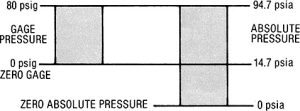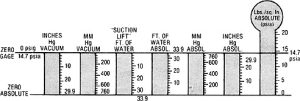Pressure The basic definition of pressure is force per unit area. As commonly used in hydraulics and in this manual, it is expressed in pounds per square inch (PSI).
Atmospheric Pressure is the force exerted on a unit area by the weight of the atmosphere. At sea level, the atmospheric standard pressure is 14.7 pounds per square inch.
Gage Pressure Using atmospheric pressure as a zero reference, gage pressure is a measure of the force per unit area exerted by a fluid. Units are PSIG.


Absolute Pressure is the total force per unit area exerted by a fluid. It equals atmospheric pressure plus gage pressure. Units are expressed in PSIA.
Outlet Pressure or discharge pressure is the average pressure at the outlet of a pump during operation, usually expressed as gage pressure (psig).
Inlet Pressure is the average pressure measured near the inlet port of a pump during operation. It is expressed either in units of absolute pressure (psig) preferably, or gage pressure (psig).
Differential Pressure is the difference between the outlet pressure and the inlet pressure. Differential pressure is sometimes called Pump Total Differential pressure.
Vacuum or Suction are terms in common usage to indicate pressures in a pumping system below normal atmospheric pressure, and are often measured as the difference between the measured pressure and atmospheric pressure in units of inches of mercury vacuum, etc. It is more convenient to discuss these in
absolute terms; that is from a reference of absolute zero pressure, in units of psia.


